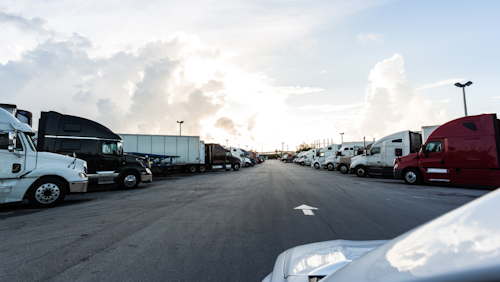Article written by Aaron Huff
This is the first of a two-part series on how the free market in freight transportation responded to the COVID-19 crisis, and if greater transparency in pricing between brokers and carriers would make a difference. Part 2 will publish on Friday.
Freight rates began to plummet in March following state-issued lockdown orders aimed at containing the spread of the novel coronavirus, and the downward trend continued through April to hit a five-year low before rebounding in May.
Automotive, retail and energy shipments were among the hardest-hit sectors, but new pockets of demand surfaced in health care, pharmaceuticals and other essential goods.
During the COVID-19 crisis, the volatility of rates have raised questions about the need for greater transparency into the costs and margins of freight transactions, particularly for logistics service providers or 3PLs.
All parties in freight transactions have access to the same historical market data for rates, but this data is compiled from averages and lacks the transparency of what actually goes into a rate for a specific contract or spot market transaction.

During the turmoil of 2020, a number of shippers, carriers and 3PLs say they have not only survived but have used it as an opportunity to come out ahead.
In the free market, the lack of cost transparency is a competitive advantage for any party in a rate negotiation. Companies on any side of a rate negotiation want to protect this information, especially since they have worked to create a lower cost structure than their competitors.
In interviews with shippers, 3PLs and carriers, the parties shared a common agreement on the difficulty of providing transparency of rate and cost structures as their variables change too frequently and are too different to be a reliable source of predictable data for making decisions.
Rate transparency is already commonplace in dedicated contracts between shippers and carriers in the form of cost-plus or gain sharing models. Rate transparency in the spot market is a different challenge since each transaction has a unique type of freight and attributes such as the number of stops, dwell times and lead time, said Alex Steurer, director of operations at ReedTMS Logistics, an asset-based 3PL based in Tampa, Florida.
The asset side of the business, Reed Transport, has approximately 100 trucks and 500 trailers.
“There is no common mold. Every lane and customer is different. There are so many variables that impact costing,” he said.
In today’s freight market, large shippers typically negotiate contracts directly with large and mid-size carriers and move a smaller percentage of their loads in the spot market, often using third-party logistics (3PL) providers for spot loads to leverage their expertise and relationships with small carriers and owner-operators.
Ultimately, it is the shippers and carriers who dictate rates in contract and spot markets based on the lanes and types of freight they are looking to buy or sell capacity for, he explained.
In addition to supply and demand, the freight market is constantly evolving from competition in the highly fragmented transport and logistics industry.
Of the approximately 560,000 carriers registered with the Federal Motor Carrier Safety Administration, 89% operate no more than 10 trucks. Of the more than 19,000 FMCSA-registered freight brokers, or 3PLs, the largest firm has no more than 4.7% market share in North America, according to Armstrong & Associates.
With so much competition, “it is really difficult to make a statement that any one person or group can really control the market,” Steurer said.
The market swings
The freight market has evolved at a quickened pace during the pandemic. One of the main contributing factors has been fluctuation in demand combined with the unpredictability of the marketplace, Steurer noted.

The freight market is constantly evolving due to competition in the highly fragmented transport and logistics industry.
Foodservice providers supplied additional capacity when local governments forced restaurants, convention centers, hotels and other venues to close, putting a large portion of their private fleets into the for-hire market.
As market rates slid, the impact on carrier revenues and profitability was more dramatic than on the margins of 3PLs, said John Elliott, CEO of Load One, an expedited transportation and logistics provider based in Taylor, Michigan, with a 400-plus-truck fleet and a 3PL freight management business, ARC Supply Chain Solutions.
Rates swung the most during the early stages of the COVID-19 outbreak, which Elliott attributes to some parties “not playing nice.” In general, when the market swings the opposite direction (in favor of carriers), the margins of 3PL margins tend to shrink.
During the coronavirus pandemic, 3PLs have seen revenue decrease and costs increase by paying more in detention and other accessorial charges to carriers, said Brandon Arnold, vice president of Intelligent Logistics, a 3PL based in Austin, Texas.
Shippers and receivers have been short-staffed at docks and their shipping volumes have been erratic, which has caused an increase in detention.
The market has been bad for carriers but not much better for 3PLs, said Anshu Prasad, CEO of Leaf Logistics, a New York City-based company that developed a freight contracting platform used by buyers (shippers and 3PLs) and sellers (carriers) to secure future transportation capacity, rates and service.

Anshu Prasad, CEO of Leaf Logistics, said his market analysis shows that freight brokers are not faring much better than carriers in this volatile market.
Before founding Leaf, Prasad led the Global Analytics practice of consulting firm A.T. Kearney for 20 years and conducted freight bids for large shippers.
“I’m not sure brokers are feasting right now,” he said.
Motor carriers may have experiences that cause them to think otherwise, but in times of crisis “the market is really inefficient and super complicated to really price correctly, fairly and transparently,” Prasad said.
During the COVID-19 crisis, market conditions have not yet been in a free fall like the Great Depression, which inspired Congress to pass the Motor Carrier Act of 1935. The law established the Interstate Commerce Commission (ICC) to grant and regulate operating authorities of carriers for specific lanes, rates and freight types.
Congress dissolved the ICC with the Motor Carrier Act of 1980, and the transportation and logistics industry has been a free market driven by supply and demand ever since.
Part 2 of this series, which runs tomorrow, will take a deeper look at the hot-button issue of rate transparency.
Original Source: https://www.ccjdigital.com/free-market-pandemic-collide-more-rates-transparency/
